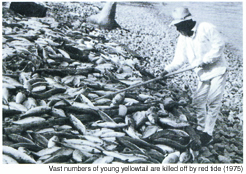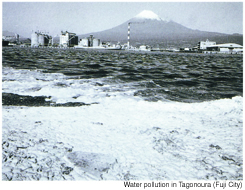Although it is believed that water pollution was an issue in Japan
before its industrial modernization, the first major recorded case
of water pollution affecting the population occurred at the turn
of the century, during Japan's Meiji Period (1868-1912), when waste
dumped into the Watarase River by the Ashio Copper Mine poisoned
local residents. Subsequently, the environmental impact of Japan's
continued industrialization made water pollution an increasingly
serious issue, with a many incidents of water pollution affecting
areas throughout Japan.
During the postwar reconstruction following WWII,
water pollution became a more serious issue, due especially to urbanization.
Toward the mid-1950s, water pollution began creating ecological
disasters, including the infamous Minamata Disease, which was a
case of mercury poisoning in southwestern Kyushu.
Local governments began responding to the issue by establishing
their own water-pollution regulations. The national government also
began to act, in 1958 establishing two laws regulating water pollution:
the Water Quality Control Law and the Industrial Effluent Control
Law. But these two laws didn't do enough to curb water pollution,
and further were restricted in scope to specific regions. They were
thus unable to answer the demand for environmental protection of
Japan's water.
Japan's rapid economic growth during the 1960s was
accompanied by water pollution of increasing severity and scope.
This period saw one ecological disaster after another, including
Minamata Disease, caused by mercury contamination in the Agano River,
and Itai-Itai Disease, caused by cadmium contamination in the Jinzu
River. Itai-Itai Disease was so called because the cadmium made
patients' bones so brittle that just touching them would cause them
to cry out "Itai! Itai!" (It hurts! It hurts!) This prompted
the national government to take stronger measures to curb water
pollution. In 1967, it enacted the Basic Law for Environmental Pollution
Control, and then in 1970, the Parliament passed a number of pioneering
anti-pollution laws. In fact, it passed so many such laws that it
was nicknamed the "Environmental Pollution Diet." The
Parliament unified the Water Quality Control Law and the Industrial
Effluent Control Law into a new and strengthened law, the Water
Pollution Control Law. Then the following year, in 1971, the Environment
Agency was established, which took over water-environment policy
in order to provide centralized oversight for environmental conservation.
 Nevertheless, during the 1970s environmental pollution became an
increasingly serious issue around the Seto Inland Sea, due to overpopulation
and growing concentration of industry. One consequence of this pollution
was increasingly frequent red tides. The government responded with
tougher measures to curb water pollution. In 1973, the Interim Law
for Conservation of the Environment of the Seto Inland Sea was enacted,
and in 1978, the law was made permanent and the term "Interim"
dropped. Also in 1978, a comprehensive and far-reaching series of
laws was enacted to regulate levels of pollutants in the Seto Inland
Sea, Tokyo Bay, Ise Bay, and other bodies of water, where organic
pollutants were a recurring issue. Then in 1984, the Law Concerning
Special Measures for the Preservation of Lake Water Quality was
enacted to combat water pollution in freshwater bodies, where measures
to date had failed to show results.
Nevertheless, during the 1970s environmental pollution became an
increasingly serious issue around the Seto Inland Sea, due to overpopulation
and growing concentration of industry. One consequence of this pollution
was increasingly frequent red tides. The government responded with
tougher measures to curb water pollution. In 1973, the Interim Law
for Conservation of the Environment of the Seto Inland Sea was enacted,
and in 1978, the law was made permanent and the term "Interim"
dropped. Also in 1978, a comprehensive and far-reaching series of
laws was enacted to regulate levels of pollutants in the Seto Inland
Sea, Tokyo Bay, Ise Bay, and other bodies of water, where organic
pollutants were a recurring issue. Then in 1984, the Law Concerning
Special Measures for the Preservation of Lake Water Quality was
enacted to combat water pollution in freshwater bodies, where measures
to date had failed to show results.
In recent years, pollution has failed to show improvement
in closed bodies of water such as bays, inland seas, and lakes and
reservoirs. Further, chemical pollution is becoming an increasingly
serious issue. In response, in 1989 the Water Pollution Control
Law was revised to prevent the pollution of the water tables by
toxic substances, and in 1990, it was revised again to strengthen
measures against pollution from sewage. Then in 1993, a series of
standards was enacted to prevent further chemical pollution of public
waters. Environmental Quality Standards (EQS) relating to human
health were greatly enhanced and strengthened, and additionally
environmental quality and wastewater standards were enacted to prevent
eutrophication and nitrification of sea and coastal areas, with
23 substances specified for monitoring. Then in 1996, the Water
Pollution Control Law was again amended, incorporating measures
to clean up groundwater pollution, and the following year (1997),
Environmental Quality Standards (EQS) were established for groundwater
pollution.
Emissions of dioxins from waste incinerators became
a major public issue in 1998. In response to the problem, the Law
Concerning Special Measures Against Dioxins was enacted in July
1999, and environmental quality and effluent control standards were
established based on the new law. Regulations controlling dioxin
emissions in wastewater became effective in January of the following
year (2000), and water quality (including groundwater) and soils
have been observed regularly since April 2000.
By 2002, there was an increasing movement toward regulating
soil pollution. The attitude of the public toward ground pollution
was changing, as awareness of the need for regulation grew as a
result of increasing discoveries of soil pollution and soil pollution
countermeasures. Based on these circumstances, the government planned
out a strategy for combating soil pollution, and in February 2002,
the Prime Minister's cabinet approved a new policy. In May of that
year, the Soil Pollution Control Law was passed by the Parliament,
and went into effect on February 15, 2003.
Today, the issues affecting the water environment
are more serious than ever, and as we have seen here, the measures
to combat them go back many years. In January 2001, the Environment
Agency was reorganized in to the Ministry of the Environment. This
represents one more step in Japan's long battle against water pollution.
The Ministry's stance is described in the following section.


 Nevertheless, during the 1970s environmental pollution became an
increasingly serious issue around the Seto Inland Sea, due to overpopulation
and growing concentration of industry. One consequence of this pollution
was increasingly frequent red tides. The government responded with
tougher measures to curb water pollution. In 1973, the Interim Law
for Conservation of the Environment of the Seto Inland Sea was enacted,
and in 1978, the law was made permanent and the term "Interim"
dropped. Also in 1978, a comprehensive and far-reaching series of
laws was enacted to regulate levels of pollutants in the Seto Inland
Sea, Tokyo Bay, Ise Bay, and other bodies of water, where organic
pollutants were a recurring issue. Then in 1984, the Law Concerning
Special Measures for the Preservation of Lake Water Quality was
enacted to combat water pollution in freshwater bodies, where measures
to date had failed to show results.
Nevertheless, during the 1970s environmental pollution became an
increasingly serious issue around the Seto Inland Sea, due to overpopulation
and growing concentration of industry. One consequence of this pollution
was increasingly frequent red tides. The government responded with
tougher measures to curb water pollution. In 1973, the Interim Law
for Conservation of the Environment of the Seto Inland Sea was enacted,
and in 1978, the law was made permanent and the term "Interim"
dropped. Also in 1978, a comprehensive and far-reaching series of
laws was enacted to regulate levels of pollutants in the Seto Inland
Sea, Tokyo Bay, Ise Bay, and other bodies of water, where organic
pollutants were a recurring issue. Then in 1984, the Law Concerning
Special Measures for the Preservation of Lake Water Quality was
enacted to combat water pollution in freshwater bodies, where measures
to date had failed to show results.